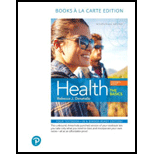
Health: The Basics, Books a la Carte Edition (13th Edition)
13th Edition
ISBN: 9780134814285
Author: Rebecca J. Donatelle
Publisher: PEARSON
expand_more
expand_more
format_list_bulleted
Question
Chapter 10, Problem 5WDYS
Summary Introduction
To identify: The difference between genetically modified foods and other conventional feeds
Introduction:
Genetically modified foods (GMFs) are foods that is produced from animal or plant whose DNA (Dyoxyribonucleic acid) has been modified through genetic engineering.
Expert Solution & Answer
Want to see the full answer?
Check out a sample textbook solution
Chapter 10 Solutions
Health: The Basics, Books a la Carte Edition (13th Edition)
Ch. 10 - Prob. 1WDYTCh. 10 - Prob. 2WDYTCh. 10 - Prob. 3WDYTCh. 10 - Prob. 1WDYSCh. 10 - What are your greatest concerns about GM foods?...Ch. 10 - In what ways could the creators of GM foods...Ch. 10 - What sort of regulation do you think the...Ch. 10 - Prob. 5WDYSCh. 10 - What is the most crucial nutrient for life? a....Ch. 10 - Prob. 2PQ
Knowledge Booster
Similar questions
- Should he go ahead and enroll on the chance that he would receive the DNA vaccine and that it would be more effective than chemotherapy? Bruce and his parents moved to a semi-tropical region of the United States when he was about 3 years old. He loved to be outside year-round and swim, surf, snorkel, and play baseball. Bruce was fair-skinned, and in his childhood years, was sunburned quite often. In his teen years, he began using sunscreens, and although he never tanned very much, he did not have the painful sunburns of his younger years. After graduation from the local community college, Bruce wanted an outdoor job and was hired at a dive shop. He took people out to one of the local reefs to snorkel and scuba dive. He didnt give a second thought to sun exposure because he used sunscreen. His employer did not provide health insurance, so Bruce did not go for annual checkups, and tried to stay in good health. In his late 20s, Bruce was injured trying to keep a tourist from getting caught between the dive boat and the dock. He went to an internist, who treated his injury and told Bruce he was going to give him a complete physical exam. During the exam, the internist noticed a discolored patch of skin on Bruces back. She told him that she suspected Bruce had skin cancer and referred him to a dermatologist, who biopsied the patch. At a follow-up visit, Bruce was told that he had melanoma, a deadly form of skin cancer. Further testing revealed that the melanoma had spread to his liver and his lungs. The dermatologist explained that treatment options at this stage are limited. The drugs available for chemotherapy have only temporary effects, and surgery is not effective for melanoma at this stage. The dermatologist recommended that Bruce consider entering a clinical trial that was testing a DNA vaccine for melanoma treatment. These vaccines deliver DNA encoding a gene expressed by the cancer cells to the immune system. This primes the immune system to respond by producing large quantities of antibodies that destroy melanoma cells wherever they occur in the body. A clinical trial using one such DNA vaccine was being conducted at a nearby medical center, and Bruce decided to participate. At the study clinic, Bruce learned that he would be in a Phase Ill trial, comparing the DNA vaccine against the standard treatment, which is chemotherapy, and that he would be randomly assigned to receive either the DNA vaccine or the chemotherapy. He was disappointed to learn this. He thought he would be receiving the DNA vaccine.arrow_forwardShould he reconsider and try chemotherapy instead? Bruce and his parents moved to a semi-tropical region of the United States when he was about 3 years old. He loved to be outside year-round and swim, surf, snorkel, and play baseball. Bruce was fair-skinned, and in his childhood years, was sunburned quite often. In his teen years, he began using sunscreens, and although he never tanned very much, he did not have the painful sunburns of his younger years. After graduation from the local community college, Bruce wanted an outdoor job and was hired at a dive shop. He took people out to one of the local reefs to snorkel and scuba dive. He didnt give a second thought to sun exposure because he used sunscreen. His employer did not provide health insurance, so Bruce did not go for annual checkups, and tried to stay in good health. In his late 20s, Bruce was injured trying to keep a tourist from getting caught between the dive boat and the dock. He went to an internist, who treated his injury and told Bruce he was going to give him a complete physical exam. During the exam, the internist noticed a discolored patch of skin on Bruces back. She told him that she suspected Bruce had skin cancer and referred him to a dermatologist, who biopsied the patch. At a follow-up visit, Bruce was told that he had melanoma, a deadly form of skin cancer. Further testing revealed that the melanoma had spread to his liver and his lungs. The dermatologist explained that treatment options at this stage are limited. The drugs available for chemotherapy have only temporary effects, and surgery is not effective for melanoma at this stage. The dermatologist recommended that Bruce consider entering a clinical trial that was testing a DNA vaccine for melanoma treatment. These vaccines deliver DNA encoding a gene expressed by the cancer cells to the immune system. This primes the immune system to respond by producing large quantities of antibodies that destroy melanoma cells wherever they occur in the body. A clinical trial using one such DNA vaccine was being conducted at a nearby medical center, and Bruce decided to participate. At the study clinic, Bruce learned that he would be in a Phase Ill trial, comparing the DNA vaccine against the standard treatment, which is chemotherapy, and that he would be randomly assigned to receive either the DNA vaccine or the chemotherapy. He was disappointed to learn this. He thought he would be receiving the DNA vaccine.arrow_forward
Recommended textbooks for you
 NutritionHealth & NutritionISBN:9781337906371Author:Sizer, Frances Sienkiewicz., WHITNEY, ElliePublisher:Cengage Learning,
NutritionHealth & NutritionISBN:9781337906371Author:Sizer, Frances Sienkiewicz., WHITNEY, ElliePublisher:Cengage Learning, Nutrition Through The Life CycleHealth & NutritionISBN:9781337919333Author:Brown, Judith E.Publisher:Cengage Learning,
Nutrition Through The Life CycleHealth & NutritionISBN:9781337919333Author:Brown, Judith E.Publisher:Cengage Learning,- Lifetime Physical Fitness & WellnessHealth & NutritionISBN:9781337677509Author:HOEGERPublisher:Cengage
 Nutrition: Concepts and Controversies - Standalo...Health & NutritionISBN:9781305627994Author:Frances Sizer, Ellie WhitneyPublisher:Brooks Cole
Nutrition: Concepts and Controversies - Standalo...Health & NutritionISBN:9781305627994Author:Frances Sizer, Ellie WhitneyPublisher:Brooks Cole

Nutrition
Health & Nutrition
ISBN:9781337906371
Author:Sizer, Frances Sienkiewicz., WHITNEY, Ellie
Publisher:Cengage Learning,

Nutrition Through The Life Cycle
Health & Nutrition
ISBN:9781337919333
Author:Brown, Judith E.
Publisher:Cengage Learning,


Lifetime Physical Fitness & Wellness
Health & Nutrition
ISBN:9781337677509
Author:HOEGER
Publisher:Cengage


Nutrition: Concepts and Controversies - Standalo...
Health & Nutrition
ISBN:9781305627994
Author:Frances Sizer, Ellie Whitney
Publisher:Brooks Cole